|

By Mike McLeod
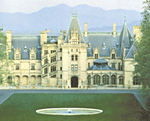 There are few places where you can really step
back in time to the turn of the century and experience the authentic
surroundings and the lifestyle of one of the richest families in
American history. The Biltmore House in Asheville, North Carolina,
is such a place, and it should be on every antiquer and collector's
list as a must-see. Paintings, engravings, lithographs, prints,
sculpture, furniture, tapestries, rugs, porcelain, glass, pottery,
books, clocks, musical instruments, clocks, weaponry, ornate and
original architecture, silver, and a conservatory filled with
hothouse plants and flowers from all over the world are showcased in
this, the largest private residence in America in its
day. There are few places where you can really step
back in time to the turn of the century and experience the authentic
surroundings and the lifestyle of one of the richest families in
American history. The Biltmore House in Asheville, North Carolina,
is such a place, and it should be on every antiquer and collector's
list as a must-see. Paintings, engravings, lithographs, prints,
sculpture, furniture, tapestries, rugs, porcelain, glass, pottery,
books, clocks, musical instruments, clocks, weaponry, ornate and
original architecture, silver, and a conservatory filled with
hothouse plants and flowers from all over the world are showcased in
this, the largest private residence in America in its
day.
When George Washington
Vanderbilt III officially opened the doors to the Biltmore on
Christmas Eve in 1895, it was after six years of a mammoth
construction project. Yet, the home was not entirely completed at
that time. Interestingly, Vanderbilt was a bachelor during the
entire process. It was not until 1898 that he became a family man
with his marriage to Edith Stuyvesant Dresser. They eventually had
one child, Cornelia.
|
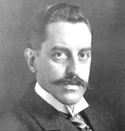
George Washington
Vanderbilt |
While
George Vanderbilt's father and grandfather amassed the great
Vanderbilt fortunes in shipping and railroad, George preferred
the life of a scholar and a traveler. He visited Europe,
Africa and Asia for an extended period of time each year
throughout his adult life, and he was fluent in seven
languages. Even so, George endeavored to make Biltmore a
working, income-generating estate. He started a dairy, which
was successful for many years; farms yielded produce, meat,
honey from 41 beehives. His forests produced 3,000 cords of
wood annually that were processed at the Biltmore's mill. A
300-acre nursery offered 5 million plants for sale. Today,
restaurants, a hotel, a winery, and beef cattle production are
thriving industries-in addition to
tourism. |
After George Vanderbilt's
unexpected death in 1914 following an emergency appendectomy, the
house eventually passed into the hands of Cornelia's sons. During
the Depression, the City of Asheville approached them to open the
house as a tourist attraction. Even charging the extremely high
price of $1 for admission, the Biltmore House and Estate attracted
many visitors during those tough times.
|

|
|
|
|

|

|
Contact
us to place your upcoming antique show
and event information here.
|
| The home
is a marvel today and was a futuristic marvel at the turn of
the century. George Vanderbilt equipped it with the latest
technological wonders-electricity, telephones, central
heating, mechanical refrigeration, elevators, fire alarms and
central plumbing. Indoor bathrooms at the time were a distinct
luxury, and the Biltmore has 43. A legged tub rested, and
washing in them with running water must have been a thrill.
Interestingly, indoor plumbing had not reached the toilet
facilities at this time, and there were no lavatories in the
bathrooms.
A bowling alley (with
wooden balls of various sizes for different games), a swimming
pool with underwater lights, a gym and private dressing rooms
provided opportunities for indoor recreation.
As you can imagine,
construction on the four-story stone home with a 375-foot
front facade required an army of workers. A village was built
outside the property just to house them, and they traveled
about three miles into the estate each day to begin work. A
private rail spur hauled building supplies, including
limestone that had already journeyed 600 miles from Indiana
and marble from Italy. On-site factories and work sheds housed
woodcarvers, a kiln that produced 32,000 bricks per day, and
wood workers who created oak and walnut flooring. A nursery
propagated 2,935,615 plants for the grounds. (Another half
million or so were collected or purchased locally; 2,870,675
were eventually planted on the estate.)
To prepare for the
great estate's interior decoration, George Vanderbilt traveled
the world. In Europe and America, he purchased custom-made
furniture in the English, Continental, and American styles.
Indeed, several rooms are named after their styles of
furniture: the Chippendale Room, the Sheraton Room, and the
Louis XVI Room.
In these rooms and
many others in the living areas, the hardwood floors are in
herring-bone-design, which attest to the attention to detail
maintained during planning and construction. |
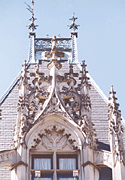
About 1,000 masons, carpenters and artisans
worked on the Biltmore House over six
years.
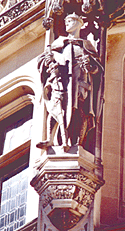
|
With a 120-page guidebook
required to detail much-but not all-of the Biltmore's treasures and
history, there is obviously only room in this article to touch on
just a few of the highlights.
| The Banquet Hall. Reminiscent of the
great feasting halls of English literature and lore, the
center of this magnificent room is dominated by an oak dining
table seating 64 chairs. The acoustics are said to make it
possible for a person at one end of the table to speak with
another at the other end without raising a voice. Adding to
the medieval motif are: two built-in, gilt-trimmed throne
chairs; triple fireplaces flanked by armor from the 1400s to
1800s; a high-relief panel, "Return from the Chase"; a
built-in sideboard with 18th and 19th century copper and brass
vessels from Spain, France and Holland; and an organ gallery.
Although not originally installed, the fully-restored, period
organ automatically plays for visitors at timed
intervals.
Adorning the walls
are five of a set of seven Flemish tapestries woven with silk,
wool and metallic thread between 1546 and 1553, depicting the
love triangle from Roman mythology of Venus, Mars (her
paramour, the god of war) and Vulcan (the jealous husband and
god of fire). These exquisite works of art appear to be about
15 feet tall and 30-40 feet in length. |
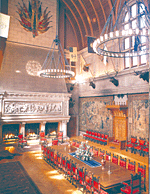
The Banquet Hall sat 65; diners marveled at the
16th c. tapestries, 15th c. armor, and gothic
ceilings. |
|
|
|
|
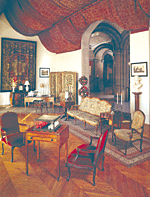
The Salon with Napoleon's chess table in
forground and chess pieces. |
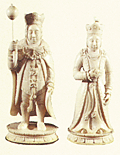 The Salon. When the men retired to the
Billiard Room, or the Smoking Room or Gun Room in the
Bachelors' Hall, the women would often go to the Salon. Here,
they would read, engage in conversation, or play
games-cribbage, checkers, mah-jongg, card games like whist and
euchre, or perhaps chess on an Empire walnut game table with
ivory pieces used by Napoleon while exiled on St. Helena
Island (1815-1821). They could consider the wonderful hangings
created for Cardinal Richelieu, the 17th century French
statesman. The hangings are velvet and stitched with
metal-thread couching depicting the cardinal's hat and
armorial bearings. The Salon. When the men retired to the
Billiard Room, or the Smoking Room or Gun Room in the
Bachelors' Hall, the women would often go to the Salon. Here,
they would read, engage in conversation, or play
games-cribbage, checkers, mah-jongg, card games like whist and
euchre, or perhaps chess on an Empire walnut game table with
ivory pieces used by Napoleon while exiled on St. Helena
Island (1815-1821). They could consider the wonderful hangings
created for Cardinal Richelieu, the 17th century French
statesman. The hangings are velvet and stitched with
metal-thread couching depicting the cardinal's hat and
armorial bearings.
The
Salon's décor is graced with 19th century Louis XV-style
settee and armchairs with their original tapestry upholstery
and a Bombé commode, 18th century Rococo. Showcased on the
walls are prints including the Albrecht Dürer (1471-1528)
woodblock engravings "The Emperor Maximilian I," and "Hercules
Killing
Euryptos." |
|
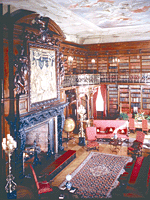
10,000 books on display in the Library. (Right:
Ceiling painting, Pelligrini's "The Chariot of
Aurora.") |
 The Library. A lover of the printed
word, George Vanderbilt kept a journal recording the books he
had read-sometimes listing many in one week. He acquired a
collection of 23,000 books in eight languages, of which about
10,000 are on display wall-to-wall, two stories high in the
library. Many are first editions and almost all are
leather-bound and gilt tinted, evidencing the care Vanderbilt
expended on his collection. He employed a librarian to catalog
his books. Author Henry James visited the Biltmore in 1905
complained that his bedroom was half a mile away from the
"mile-long library." The Library. A lover of the printed
word, George Vanderbilt kept a journal recording the books he
had read-sometimes listing many in one week. He acquired a
collection of 23,000 books in eight languages, of which about
10,000 are on display wall-to-wall, two stories high in the
library. Many are first editions and almost all are
leather-bound and gilt tinted, evidencing the care Vanderbilt
expended on his collection. He employed a librarian to catalog
his books. Author Henry James visited the Biltmore in 1905
complained that his bedroom was half a mile away from the
"mile-long library."
Other antiques and art decorate
the library in addition to the books. On the ceiling is the
Giovanni Antonio Pelligrini (1675-1741) painting "The Chariot
of Aurora" that was originally in the Pisani Palace in Venice.
Measuring 64 feet by 32 feet on 13 canvases, it depicts the
dawn and symbolizes the light of learning. Giant Ming Dynasty
urns that were used as goldfish bowls rest among walnut and
silk damask settees, armchairs and sidechairs in 19th c.
Baroque style.
|
Mrs. Vanderbilt's
Bedroom. Edith Stuyvesant Vanderbilt was a descendant of
Peter Stuyvesant, the first governor of Dutch colonial New York.
Orphaned at 10, she was raised by her maternal grandmother. Richly
appointed in gold and purple décor, the room appears today as it did
at Edith's arrival.
Oval-shaped with golden
silk wall covering, Savonnerie carpets and cut-velvet drapes, the
room is decorated in Louis XV style. Two French period marble-topped
commodes accompany the fireplace. The room is also appointed with a
print by Peter Paul Reubens (1577-1640) and others from Germany, the
Netherlands, France and Flanders and a Louis XV clock by Phillipe
Barat with elaborate porcelain figures and flowers.
|
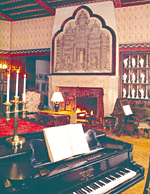
The Music Room with 18th c. woodcut print of
Maximilian I over the mantle and Meissen porcelain 12 apostles
to the right. |
The Music Room. Planned, but not
completed, the Music Room was restored and opened in 1970.
Certainly, the 20th c. Steinway piano is beautiful, but the
eye cannot be kept from the "Triumphal Arch of Maximilian," an
18th c. woodcut print Holy Roman Emperor Maximilian I
(1459-1519) commissioned from Albrecht Dürer and others about
1515. Ten feet tall and wide in 192 separate printed blocks,
the cathedral-like design elaborates military and political
events, depicts the emperor's accomplishments in linguistics
and hunting, and lists a family tree.
Also of acute
interest in the Music Room are the Meissen porcelain figures
of the 12 Apostles from the mid-1700s. Created by Johann
Joachim Kändler in the Meissen factory, the pieces are from
several different sets made for the Empresses Amalia and Maria
Theresa of the Austrian Hapsburgs. |

St.
Matthew |
Not commonly known, the
National Gallery of Art in Washington, D.C., stored paintings at the
Biltmore during WWII to protect them in case the war went
badly.
| The Bedrooms and Hallways. With too
many to detail and too much to elaborate on, just a couple of
notes: in the Chippendale Room are two Renoir's, "Young
Algerian Girl" and "Child with an Orange."
The walls of all
rooms and the hallways are filled with art and prints. Being a
great collector of prints, Vanderbilt amassed about 1,600
etchings, woodcuts, aquatints, photogravures and other
prints.
In another area was a
magnificent display of Japanese porcelain, lacquerware,
netsuke, and three samurai swords purchased by George
Vanderbilt. On that buying trip, 11 crates of Japanese
antiques came home to the Biltmore, and next year that room
will be restored and many of those pieces
displayed. |

Renoir's
"Young Algerian
Girl" |
|
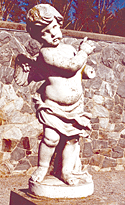
Stone carvers created unique sculpture for the
facade and gardens.
|
Unfortunately, there is not space here to do justice to
the antiques of the Biltmore House or to adequately describe
the gymnasium, tile swimming pool, kitchen areas, servants'
quarters and common rooms, laundry, drying room, the gardens,
conservatory, winery, or the stable. Hopefully, this hors
d'oeuvre of an article will just whet your appetite for a
visit to the incredible Biltmore Estate.
Our thanks
to the Biltmore Estate for providing photos and the
information for this article, especially that listed in A
Guide To Biltmore Estate that was used extensively. To plan
your visit to the Biltmore, visit http://www.biltmore.com/ or call
800-624-1575.
2002
|
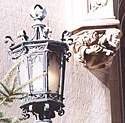

| |